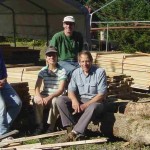 Although a significant challenge, successful planting and establishment is of course only the first step towards restoring a forest. Moist tropical forests tend to have much higher tree species richness and diversity than do our temperate forests. While a forest in the Coast Range or Cascades of Oregon may have a dozen or so trees and shrubs (and is often dominated by just a few tree species) a similar area hill evergreen forest in Northern Thailand may have 100 to 150 species.
Although a significant challenge, successful planting and establishment is of course only the first step towards restoring a forest. Moist tropical forests tend to have much higher tree species richness and diversity than do our temperate forests. While a forest in the Coast Range or Cascades of Oregon may have a dozen or so trees and shrubs (and is often dominated by just a few tree species) a similar area hill evergreen forest in Northern Thailand may have 100 to 150 species.
Replicating or recreating this diverse forest in one fell swoop at planting is impractical, or impossible. There are significant challenges of producing so many species in the nursery and also, many species seem poorly adapted to the harsh conditions of abandoned farm fields, and simply do not survive and prosper. Restoring a forest means restoring conditions and processes which in turn help create the forest.
After screening over 400 species, FORRU selected about 20 hardy species to plant as the “framework” for the future forest structure and processes. Species were selected according to their suitability to nursery production, survival and growth in abandoned field conditions, as well as to represent different growth forms and several successional stages. A great many of the selected framework species bear fruit, which is meant to encourage birds to visit the site in the hopes that they will carry in other native species. This is a key idea behind the framework species approach (adapted from Australia): along with changing the physical environment (light, leaf litter and organic matter) to favor establishment and survival of additional species, the planting needs to encourage mechanisms that deliver those species to the site. Initial findings are promising, with an increase in the number of birds and small mammals observed, and over 70 additional tree species recruited to the study plots.
But what will be the fate of those new seedlings? Does their presence today tell us what the future forest will be?
Most foresters and woodland owners in Oregon have seen a carpet of seedlings emerge on the forest floor following a thinning or other disturbance that lets more light reach the ground and maybe exposes some soil. Douglas-fir, grand fir, hemlock, alder and maple may all show up in abundance. Familiarity with our local species tell us that the fate of these seedlings is not the same. Douglas-fir generally will not grow to maturity in those conditions, while the hemlock or maple might.
Hathai (my graduate student) is trying to develop a similar understanding of the trees which make up the hill evergreen forests in Thailand. Her work on the regeneration dynamics of trees in the understory should help people here in Thailand have a better idea of the likely fate of the seedlings, and if their arrival heralds development of more complex and diverse forests in the future. Her work may also suggest ways to manage the plantings to best meet the restoration/management goals.
Brad Withrow-Robinson








